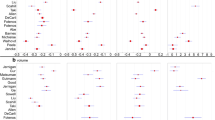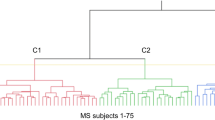Abstract
Introduction
Measurement of the upper cervical cord area (UCCA) from brain MRI may be an effective way to quantify spinal cord involvement in neurological disorders such as multiple sclerosis. However, knowledge on the determinants of UCCA in healthy controls (HCs) is limited.
Methods
In two cohorts of 133 and 285 HCs, we studied the influence of different demographic, body-related, and brain-related parameters on UCCA by simple and partial correlation analyses as well as by voxel-based morphometry (VBM) across both cerebral gray matter (GM) and white matter (WM).
Results
First, we confirmed the known but moderate effect of age on UCCA in the older cohort. Second, we studied the correlation of UCCA with sex, body height, and total intracranial volume (TIV). TIV was the only variable that correlated significantly with UCCA after correction for the other variables. Third, we studied the correlation of UCCA with brain-related parameters. Brain volume correlated stronger with UCCA than TIV. Both volumes of the brain tissue compartments GM and WM correlated with UCCA significantly. WM volume explained variance of UCCA after correction for GM volume, whilst the opposite was not observed. Correspondingly, VBM did not yield any brain region, whose GM content correlated significantly with UCCA, whilst cerebral WM content of cerebrospinal tracts strongly correlated with UCCA. This latter effect increased along a craniocaudal gradient.
Conclusion
UCCA is mainly determined by brain volume as well as by WM content of cerebrospinal tracts.




Similar content being viewed by others
References
Healy BC, Arora A, Hayden DL, Ceccarelli A, Tauhid SS, Neema M, Bakshi R (2012) Approaches to normalization of spinal cord volume: application to multiple sclerosis. J Neuroimaging 22:e12–19
Kameyama T, Hashizume Y, Sobue G (1996) Morphologic features of the normal human cadaveric spinal cord. Spine (Phila Pa 1976) 21:1285–1290
Losseff NA, Webb SL, O'Riordan JI, Page R, Wang L, Barker GJ, Tofts PS, McDonald WI, Miller DH, Thompson AJ (1996) Spinal cord atrophy and disability in multiple sclerosis. A new reproducible and sensitive MRI method with potential to monitor disease progression. Brain 119:701–708
Anderson VM, Fernando KT, Davies GR, Rashid W, Frost C, Fox NC, Miller DH (2007) Cerebral atrophy measurement in clinically isolated syndromes and relapsing remitting multiple sclerosis: a comparison of registration-based methods. J Neuroimaging 17:61–68
Agosta F, Lagana M, Valsasina P, Sala S, Dall'Occhio L, Sormani MP, Judica E, Filippi M (2007) Evidence for cervical cord tissue disorganisation with aging by diffusion tensor MRI. NeuroImage 36:728–735
Ishikawa M, Matsumoto M, Fujimura Y, Chiba K, Toyama Y (2003) Changes of cervical spinal cord and cervical spinal canal with age in asymptomatic subjects. Spinal Cord 41:159–163
Yanase M, Matsuyama Y, Hirose K, Takagi H, Yamada M, Iwata H, Ishiguro N (2006) Measurement of the cervical spinal cord volume on MRI. J Spinal Disord Tech 19:125–129
Rashid W, Davies GR, Chard DT, Griffin CM, Altmann DR, Gordon R, Kapoor R, Thompson AJ, Miller DH (2006) Upper cervical cord area in early relapsing-remitting multiple sclerosis: cross-sectional study of factors influencing cord size. J Magn Reson Imaging 23:473–476
Freund PA, Dalton C, Wheeler-Kingshott CA, Glensman J, Bradbury D, Thompson AJ, Weiskopf N (2010) Method for simultaneous voxel-based morphometry of the brain and cervical spinal cord area measurements using 3D-MDEFT. J Magn Reson Imaging 32:1242–1247
Nunneman S, Wohlschläger AM, Gaser C, Ilg R, Conrad B, Zimmer C, Mühlau M (2009) Accelerated aging of the putamen in men but not in women. Neurobiol Aging 30:147–151
Mühlau M, Winkelmann J, Rujescu D, Giegling I, Koutsouleris N, Gaser C, Arsic M, Weindl A, Reiser M, Meisenzahl EM (2012) Variation within the Huntington's disease gene influences normal brain structure. PLoS One 7:e29809
Liptak Z, Berger AM, Sampat MP, Charil A, Felsovalyi O, Healy BC, Hildenbrand P, Khoury SJ, Weiner HL, Bakshi R, Guttmann CR (2008) Medulla oblongata volume: a biomarker of spinal cord damage and disability in multiple sclerosis. AJNR Am J Neuroradiol 29:1465–1470
Bezzola L, Merillat S, Gaser C, Jancke L (2011) Training-induced neural plasticity in golf novices. J Neurosci 31:12444–12448
Ashburner J (2007) A fast diffeomorphic image registration algorithm. NeuroImage 38:95–113
Good CD, Johnsrude I, Ashburner J, Henson RN, Friston KJ, Frackowiak RS (2001) Cerebral asymmetry and the effects of sex and handedness on brain structure: a voxel-based morphometric analysis of 465 normal adult human brains. NeuroImage 14:685–700
Good CD, Johnsrude IS, Ashburner J, Henson RN, Friston KJ, Frackowiak RS (2001) A voxel-based morphometric study of ageing in 465 normal adult human brains. NeuroImage 14:21–36
Hartley SW, Scher AI, Korf ES, White LR, Launer LJ (2006) Analysis and validation of automated skull stripping tools: a validation study based on 296 MR images from the Honolulu Asia aging study. NeuroImage 30:1179–1186
Miller AK, Corsellis JA (1977) Evidence for a secular increase in human brain weight during the past century. Ann Hum Biol 4:253–257
Peters M (1991) Sex differences in human brain size and the general meaning of differences in brain size. Can J Psychol 45:507–522
Friston KJ, Holmes A, Poline JB, Price CJ, Frith CD (1996) Detecting activations in PET and fMRI: levels of inference and power. NeuroImage 4:223–235
Ho KC, Gwozdz JT, Hause LL, Antuono PG (1992) Correlation of neuronal cell body size in motor cortex and hippocampus with body height, body weight, and axonal length. Int J Neurosci 65:147–153
Barkovich AJ (2000) Concepts of myelin and myelination in neuroradiology. AJNR Am J Neuroradiol 21:1099–1109
Sherman JL, Nassaux PY, Citrin CM (1990) Measurements of the normal cervical spinal cord on MR imaging. AJNR Am J Neuroradiol 11:369–372
Kerbrat A, Aubert-Broche B, Fonov V, Narayanan S, Sled JG, Arnold DA, Banwell B, Collins DL (2012) Reduced head and brain size for age and disproportionately smaller thalami in child-onset MS. Neurology 78:194–201
Nopoulos PC, Aylward EH, Ross CA, Mills JA, Langbehn DR, Johnson HJ, Magnotta VA, Pierson RK, Beglinger LJ, Nance MA, Barker RA, Paulsen JS (2011) Smaller intracranial volume in prodromal Huntington's disease: evidence for abnormal neurodevelopment. Brain 134:137–142
Acknowledgments
MM and VB received support from Merck Serono (Project: The Upper Cervical Cord Area Determined From Cranial MRI as a Marker of Disease Severity in Multiple Sclerosis). Further, MM received support from the German Ministry for Education and Research (BMBF) (German Competence Network Multiple Sclerosis, KKNMS; 01GI1307B).
Conflict of interest
We declare that we have no conflict of interest.
Author information
Authors and Affiliations
Corresponding author
Rights and permissions
About this article
Cite this article
Engl, C., Schmidt, P., Arsic, M. et al. Brain size and white matter content of cerebrospinal tracts determine the upper cervical cord area: evidence from structural brain MRI. Neuroradiology 55, 963–970 (2013). https://doi.org/10.1007/s00234-013-1204-3
Received:
Accepted:
Published:
Issue Date:
DOI: https://doi.org/10.1007/s00234-013-1204-3




